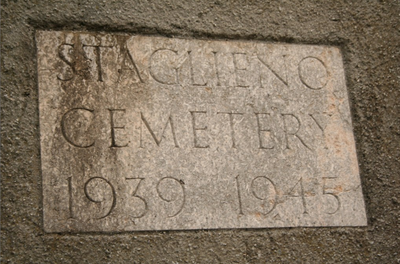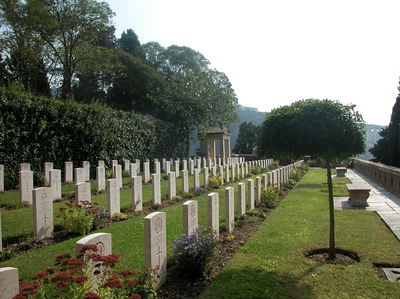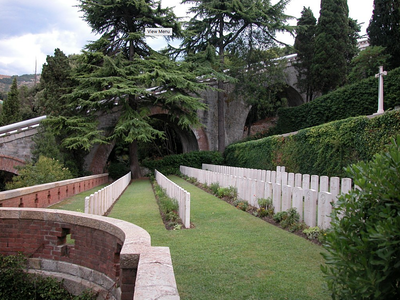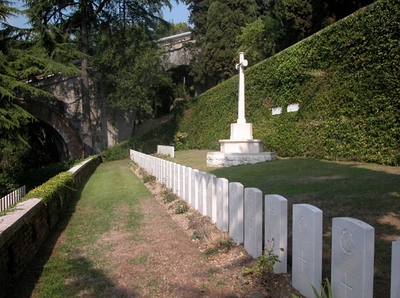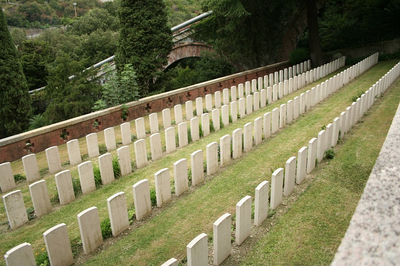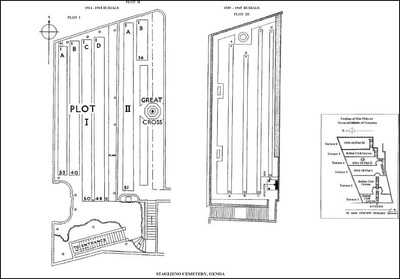STAGLIENO CEMETERY
Genoa
Italy
Location Information
Exit at the A12 autostrada at Genova East and follow the signs for the direction of Genova. The road leads down a steep hill through several tunnels.
At the bottom of the hill turn right and follow the road for a short distance alongside the riverbed. Take the first bridge to the left and cross to the opposite side of the river and turn left. Due to the one-way traffic system it is now necessary to cross the river again. Take the first bridge to the left, then turn left at the opposite bank. Take the first right just past a very small bus depot. A large Italian communal cemetery is visible on the right.
Parking is available outside the communal cemetery. Walk through the large entrance gate into the communal cemetery and follow the road straight ahead. Signs for 'British Cemetery' are seen on the right after approximately 300 metres.
Cemetery address: Piazzale Resasco - 16100 Genoa (GE) Liguria.
Visiting Information
This cemetery is steeply terraced with numerous steps.
It is necessary to climb the stairway to reach the CWGC Plots, which are on separate terraced levels connected by stairs. The 1914-18 Plots I and II are on Terraces 3 and 4, the 1939-1945 Plot (now known as Plot III) is on Terrace 6. (see layout plan).
This cemetery is in the control of the communal authorities who reserve the right to close it at anytime without notice.
The location or design of this site makes wheelchair access impossible.
Historical Information
The Italians entered the war on the Allied side, declaring war on Austria, in May 1915. Commonwealth forces were at the Italian front between November 1917 and November 1918, and rest camps and medical units were established at various locations in northern Italy behind the front, some of them remaining until 1919.
From November 1917 to the end of the war, Genoa was a base for commonwealth forces and the 11th General, and 38th and 51st Stationary Hospitals, were posted in the city.
Staglieno Cemetery contains 230 Commonwealth burials of the First World War. There are also 122 Second World War graves, most of them garrison burials, whilst others were brought in from the surrounding country. The 1939-45 plot was designed by Louis de Soissons.
Pictures used with the permission of the Commonwealth War Graves Commission
Exit at the A12 autostrada at Genova East and follow the signs for the direction of Genova. The road leads down a steep hill through several tunnels.
At the bottom of the hill turn right and follow the road for a short distance alongside the riverbed. Take the first bridge to the left and cross to the opposite side of the river and turn left. Due to the one-way traffic system it is now necessary to cross the river again. Take the first bridge to the left, then turn left at the opposite bank. Take the first right just past a very small bus depot. A large Italian communal cemetery is visible on the right.
Parking is available outside the communal cemetery. Walk through the large entrance gate into the communal cemetery and follow the road straight ahead. Signs for 'British Cemetery' are seen on the right after approximately 300 metres.
Cemetery address: Piazzale Resasco - 16100 Genoa (GE) Liguria.
Visiting Information
This cemetery is steeply terraced with numerous steps.
It is necessary to climb the stairway to reach the CWGC Plots, which are on separate terraced levels connected by stairs. The 1914-18 Plots I and II are on Terraces 3 and 4, the 1939-1945 Plot (now known as Plot III) is on Terrace 6. (see layout plan).
This cemetery is in the control of the communal authorities who reserve the right to close it at anytime without notice.
The location or design of this site makes wheelchair access impossible.
Historical Information
The Italians entered the war on the Allied side, declaring war on Austria, in May 1915. Commonwealth forces were at the Italian front between November 1917 and November 1918, and rest camps and medical units were established at various locations in northern Italy behind the front, some of them remaining until 1919.
From November 1917 to the end of the war, Genoa was a base for commonwealth forces and the 11th General, and 38th and 51st Stationary Hospitals, were posted in the city.
Staglieno Cemetery contains 230 Commonwealth burials of the First World War. There are also 122 Second World War graves, most of them garrison burials, whilst others were brought in from the surrounding country. The 1939-45 plot was designed by Louis de Soissons.
Pictures used with the permission of the Commonwealth War Graves Commission
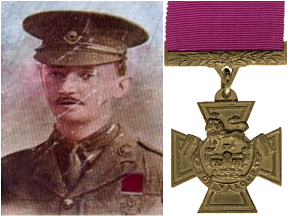
Captain Eric Archibald McNair, V. C.
9th Bn. Royal Sussex Regiment, attached to G. H. Q., died 12th August 1918, aged 24. Plot I. B. 32.
Son of George Burgh McNair and Isabella Frederica McNair, of 5, Harrington St., Calcutta.
Citation: An extract from "The London Gazette" No. 29527, dated 28th March, 1916, records the following:- "For most conspicuous bravery. When the enemy exploded a mine, Lieutenant McNair and many men of two platoons were hoisted into the air, and many men were buried. But, though much shaken, he at once organised a party with a machine gun to man the near edge of the crater and opened rapid fire on a large party of the enemy, who were advancing. The enemy were driven back, leaving many dead. Lieutenant McNair then ran back for reinforcements, and sent to another unit for bombs, ammunition and tools to replace those buried. The communication trench being blocked he went across the open under heavy fire and led up the reinforcements the same way. His prompt and plucky action and example undoubtedly saved the situation."
9th Bn. Royal Sussex Regiment, attached to G. H. Q., died 12th August 1918, aged 24. Plot I. B. 32.
Son of George Burgh McNair and Isabella Frederica McNair, of 5, Harrington St., Calcutta.
Citation: An extract from "The London Gazette" No. 29527, dated 28th March, 1916, records the following:- "For most conspicuous bravery. When the enemy exploded a mine, Lieutenant McNair and many men of two platoons were hoisted into the air, and many men were buried. But, though much shaken, he at once organised a party with a machine gun to man the near edge of the crater and opened rapid fire on a large party of the enemy, who were advancing. The enemy were driven back, leaving many dead. Lieutenant McNair then ran back for reinforcements, and sent to another unit for bombs, ammunition and tools to replace those buried. The communication trench being blocked he went across the open under heavy fire and led up the reinforcements the same way. His prompt and plucky action and example undoubtedly saved the situation."
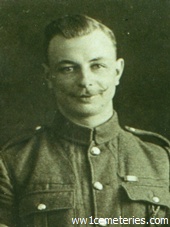
61132 Bombardier
Harry Coulson
25th Bty. 35th Bde. Royal Artillery
Died of influenza 2nd November 1918, aged 26.
Plot I. D. 34.
Husband of Rosalie Coulson, of 64, Mineral St., Plumstead, London.
Picture courtesy of Paul Bown.
Harry Coulson
25th Bty. 35th Bde. Royal Artillery
Died of influenza 2nd November 1918, aged 26.
Plot I. D. 34.
Husband of Rosalie Coulson, of 64, Mineral St., Plumstead, London.
Picture courtesy of Paul Bown.
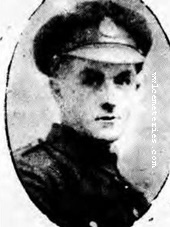
55507 Private
Thomas Peatman
24th Bn. Manchester Regiment
31st October 1918, aged 25.
Plot I. D. 20.
Son of Joseph and Susannah Peatman, of 45, Kimberley Rd., Cambridge.
Thomas Peatman
24th Bn. Manchester Regiment
31st October 1918, aged 25.
Plot I. D. 20.
Son of Joseph and Susannah Peatman, of 45, Kimberley Rd., Cambridge.

